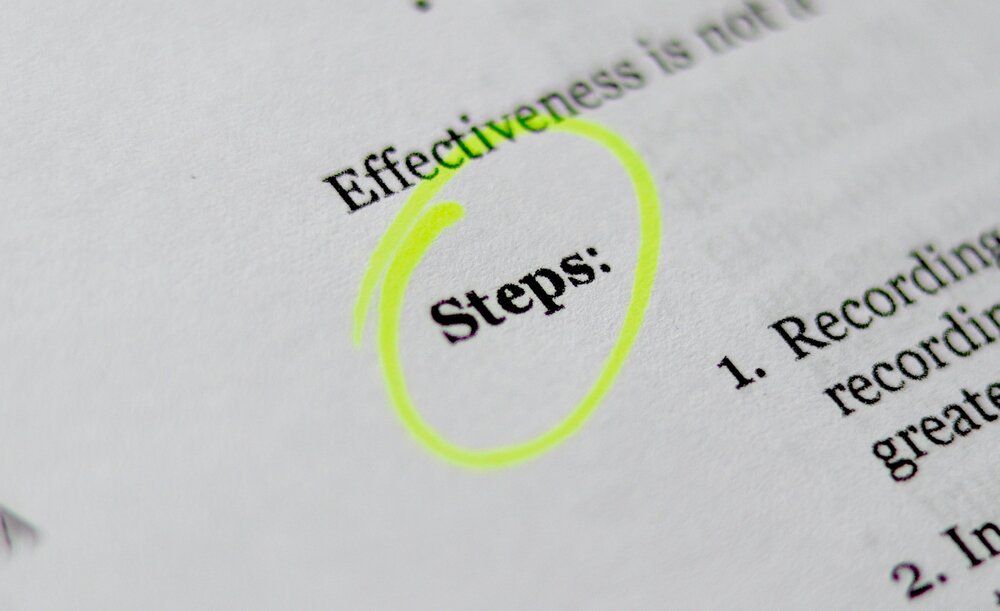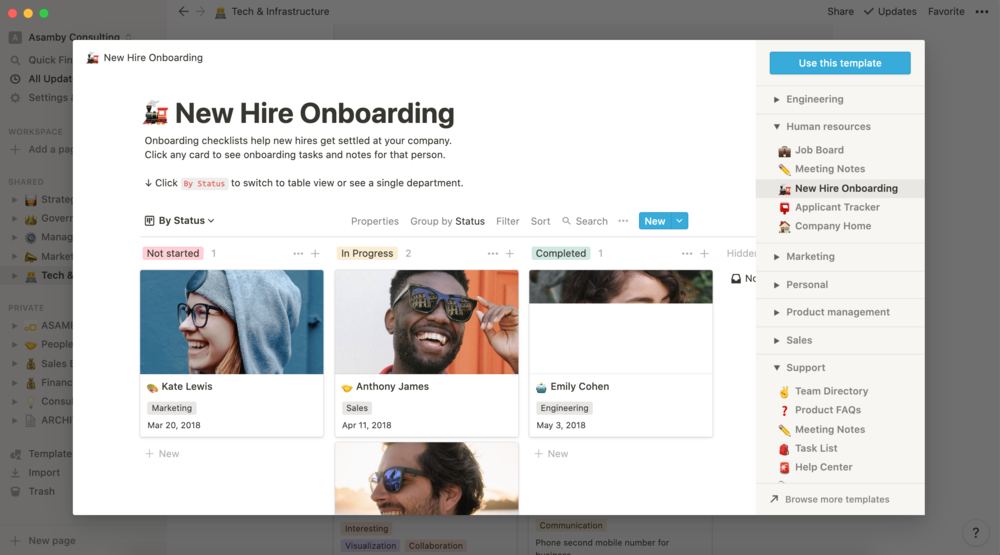
Standard Operating Procedure
When you grow, you need to bring on new people and standardize your operations. Standard operating procedures are a central tool for this. But how do you write them? Check this blog post for a step-by-step guide on how to write standard operating procedures.
What is a standard operating procedure?
A standard operating procedure – or SOP for short – is a detailed description of how your team completes a given task or set of tasks. They are part of most mature management systems.
They outline responsibilities, single steps and quality gates and serve as an operations manual for routine procedures. If you want to put it like this, it’s the cookbook for your business, filled with recipes on how you accomplish what you do.
This blog post will give you detailed step-by-step instructions on how to write standard operating procedures. Also, you will find the link to a standard operating procedure template/operations manual template further down.
Step 1: Define the purpose of creating your SOP
First, think about why you want to create standard operating procedures in the first place. Usually, our clients approach us with six different purposes:
- You want to grow: To do that, you will bring on new people, and the SOPs will serve as an onboarding tool.
- You want to ensure quality: You want to make sure your team makes no mistakes when executing the process, and thus you want to give them SOPs as a working tool for quality control. Also, writing down your lessons learned from earlier process execution will serve as best practice for the future.
- You need transparency: Your business has grown quite a bit, and the process know-how is mainly in your team’s heads. You want to institutionalize this knowledge.
- You want to achieve process improvement for specific procedures: When you want to start a business process optimization project, the first step is always to capture the status quo.
- You want to create new processes: In this case, the standard operating procedure is merely the template to write down your future process.
- You are looking to be certified: If you want to achieve a quality management certification like ISO 9001 or need proof that you comply with regulations from governing bodies like the FDA, you will need documented SOPs. Ax mentioned under 3, SOPs are an integral part of any quality management system.
The standard operating procedure structure will always be similar, but the details of the finish might differ a bit depending on your purpose.
You can write SOPs for any process you want. Standard operating procedures examples for small businesses are
- Onboarding of a new employee
- Closing of a new client
- Fulfilling an order
- Processing payroll
There is no limit. You can write down whatever you want to standardize. Of course, SOP works best for recurring tasks that doesn’t differ too much in structure.
Defining the reason why and for whom you are writing your SOPs will give the endeavor a clear direction
Step 2: Define the format of your standard operating procedures
There’s a variety of formats for process documentation that have been defined by global standardization bodies like ISO. Where large corporations use them, we usually recommend an individual approach to choose what’s important for your specific business and use case.

No matter what you want you standard operating procedures to look like, it pays off to think about a template structure.
The consistency this creates will help with adoption and later updates. And it’s just easier to just grab one of your SOP templates and start working when you want to design a new process.
Bringing in an operations’ person might help push through an SOP project. Check out our blog post about Ops Manager vs COO here.
As a minimum structure, we recommend the following standard operating procedure checklist:
- Name of the process / Title of the procedure
- Owner
- Date published and next review date
- Related SOPs (the first four points are part of the title page)
- Actual body, step-by-step procedure descriptions
- Graphics where possible
- Health and safety topics if applicable to your processes
Additionally, you could add:
- Procedure ID / SOP identification number
- A short title
- Table of contents
- Clarification of terminology, acronyms and abbreviations
- Flow Charts
- Change and revision history
- Approval workflows
- And, most importantly: Whatever you think is essential. It’s your document, so you make the rules! Many of our clients, for example, like to use tutorial videos.
You’ll find a free standard operating procedures template further down. And remember: No one said SOPs have to be boring. Be creative, and make them fun to read or use – this will increase adoption.
Step 3: Define the medium for your standard operating procedures documentation

The format of your SOP documentation is critical, as it must suit your use-case – otherwise adoption will be poor. People mostly think about long, contract-like word- or PDF documents when they hear the term standard operating procedure.
But there is a huge variety of different options for your sop format that – in our experience – serve a smaller but growing company much better than the traditional document based solutions. There are specific reasons to choose one over the other.
- Notes or wiki software: A great option for your standard operating procedures. Usually, this type of software allows you to easily integrate many different media types such as workflow diagrams into your standard operating procedures. Also, you can easily track change history and cooperate on your SOPs. A great example is Notion.CHECK OUT OUR BLOG POST ON HOW TO BUILD A GREAT COMPANY WIKI HERE.
- Process documentation software: Another more narrow but more automated way of documenting, especially rather simple SOPs. The big advantage is that the user, your team member, not only can read the procedure description but will be guided through the actual steps of execution. Sophisticated tools also include approvals and other workflows. A good example here is Process Street.
- Project management software: Most modern project management tools include the functionality to create templates that can well serve as a ready-to-use SOPs.
- Digital Workspace tools that combine all of the above. A great example is Kissflow.
- Document software: The classic format for SOPs are procedural documents, so simple document software can be the choice for you in specific cases. Make sure the documents are stored in the cloud to easily link them in new SOPs you create. Also, you make sure that people don’t use old PDF versions you sent around years ago.
As we think that impact is far more important than excellent documents, we would strongly recommend using one of the more interactive software choices to make adoption easy.
Step 4: Talk to the subject matter experts
Especially for the business owner, there’s a great temptation to write down SOPs yourself. Resist that temptation and make sure you interview the people that have the best knowledge of the process you are trying to capture.

The subject-matter expert is the best source for capturing the status quo of a process. To be sure, we are talking about your team.
After all, it’s them executing the process day-in, day-out. And what’s the point if you write down something yourself that is not what’s happening in reality.
The goal of your SOP in the first step should be to capture a snapshot of how work is being performed.
Set up a meeting with the subject-matter expert to go through the process step by step. Here are some questions that can guide you when trying to get the best answers:
- What is your input, what is your output.
- What triggers the process (time, an event, etc.)
- What is the first step? What are the specific steps after this?
- What triggers the next step?
- Who do you consult, need approval of?
- Are there colleagues or other departments that you need to complete the task?
- What tools (software or physical tools) do you use?
- Are there related processes that you need to complete the task?
- After you completed the task, what happens next?
In this step of capturing the status quo, it is best to resist the urge to start improving processes right away. It will be much easier, in the long run, to first write down what is, and then start improving.

If there are risky or dangerous behaviors involved, you obviously should fix them right away. Safety warnings shouldn’t wait.
As interviewing and documenting the current state of SOPs will need quite some resources, it is useful to set up a project plan for this and allocate some time to it.
Step 5: Write down the standard operating procedure
WRITE DOWN THE META-INFORMATION FOR YOUR SOP
Setting the framework of first outlining the meta-information will give you clarity and guidance over what you are working on.
This meta-information should also include a date on when you plan to review the SOP. Let’s say you start writing an SOP today and expect to finish it in one month, then you could set a review date for seven months from now.
Or go for a full year if the process and your business are rather stable. Either way, define when the SOP is going to be reviewed. Reviews are usually done or at least triggered by the owner of the SOP.
WRITE DOWN THE ACTUAL OPERATING PROCEDURE
Now you are getting to the core of writing a standard operating procedure. The goal here is to write down how to perform a task in the perfect balance between a sufficient level of detail on the one hand and simplicity on the other hand.
It also pays off that you laid out the purpose of writing SOP: The purpose will determine the level of detail and the media you use.
If the SOP will mainly be used to onboard new colleagues, use rich media like videos, screenshots, graphics, diagrams and illustrations, which are generally easier to understand than plain text.
Also for SOPs that are more complex, the use of rich media is highly recommendable. Short and simple sentences are always recommended.
What a good SOP looks like depends on its purpose: If the main goal is to capture current processes, you might only go for a high-level written SOP.
On the other hand, if you want to improve existing processes, you will most likely include details as this where the potential for improvement lies.
When creating new process, you want to keep things general initially to become more specific over time.
But regardless of your level of detail, be 100% unambiguous! Add graphics, files, videos and whatever else will serve your purpose.
Throughout the process, try to get iterative feedback from your stakeholders. The first draft will most likely not be the final version, but will grow with constant feedback of the team.
Step 6: Get the approval of all stakeholders
This step in writing an SOP is often overlooked, but we can’t stress how important it is: Get approval from all SOP stakeholders for your drafts. Relevant stakeholders can be:
- Team members that work using the SOP
- Supervisors, team leads, bosses
- Internal partners that need to contribute to the SOP
Why is it so essential to get the stakeholders to approve of the SOP? Because the written SOP is the fundamental basis for whatever else will be done next to that specific process.
Be it process improvement or training measures, you have to make sure that you get this basis right.

We recommend having the team members sign off on the SOP (physically or digitally). This act will give the approval enough weight to make people actually read the standard operating procedure for evaluation.
Last but not least, signing off SOPs will be necessary for health & safety SOPs or procedures handling hazards.
So go get those physical or digital signatures!
Step 7: Implementation – put the SOP to use
The last step rewards you for all your work: Put the standard operating procedure to action! Again, depending on your purpose, it might differ what that action is, but here are the options.
- Communicate: If you’re merely documenting existing processes, it should be enough just to communicate the finalized SOP. Publish it in the place you chose in step, and don’t forget to share it in your team meeting or huddle.
- Drive adoption: when you’ve made changes to existing processes or created new processes, you need to drive adoption among your team members. An SOP itself won’t be able to change how people work. But an SOP with high compliance standards will become a central tool for quality management.
- Integrate the SOP into your onboarding plan: No matter if this was the main focus of writing a standard operating procedure, take the result and make it part of onboarding new employees.
- When you created the SOP as a basis to achieve process improvement, start that.
Congratulations!
You made it! You have written a standard operating procedure!
Download a free standard operating procedure template here.
Have fun writing yours and let us know if you need any help – use the chat function or the contact form.
Happy Scaling!
Best
Benjamin